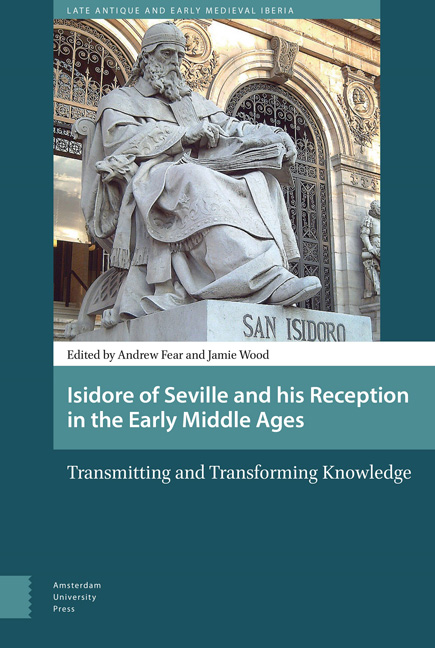 Isidore of Seville and his Reception in the Early Middle Ages
Isidore of Seville and his Reception in the Early Middle Ages Book contents
- Frontmatter
- Contents
- Preface: Paul Fouracre, University of Manchester
- 1 Introduction
- 2 A Family Affair: Leander, Isidore and the Legacy of Gregory the Great in Spain
- 3 Variations on a Theme: Isidore and Pliny on Human and Human-Instigated Anomaly
- 4 Putting the Pieces Back Together: Isidore and De Natura Rerum
- 5 The Politics of History-Writing: Problematizing the Historiographical Origins of Isidore of Seville in Early Medieval Hispania
- 6 Isidorian Texts in Seventh-Century Ireland
- 7 Isidore of Seville in Anglo-Saxon England: The Synonyma as a Source of Felix’s Vita S. Guthlaci
- 8 Hispania et Italia: Paul the Deacon, Isidore, and the Lombards
- 9 Rylands MS Latin 12: A Carolingian Example of Isidore’s Reception into the Patristic Canon
- 10 Adoption, Adaptation, & Authority: The Use of Isidore in the Opus Caroli
- Abbreviations
- Index
4 - Putting the Pieces Back Together: Isidore and De Natura Rerum
Published online by Cambridge University Press: 12 December 2020
- Frontmatter
- Contents
- Preface: Paul Fouracre, University of Manchester
- 1 Introduction
- 2 A Family Affair: Leander, Isidore and the Legacy of Gregory the Great in Spain
- 3 Variations on a Theme: Isidore and Pliny on Human and Human-Instigated Anomaly
- 4 Putting the Pieces Back Together: Isidore and De Natura Rerum
- 5 The Politics of History-Writing: Problematizing the Historiographical Origins of Isidore of Seville in Early Medieval Hispania
- 6 Isidorian Texts in Seventh-Century Ireland
- 7 Isidore of Seville in Anglo-Saxon England: The Synonyma as a Source of Felix’s Vita S. Guthlaci
- 8 Hispania et Italia: Paul the Deacon, Isidore, and the Lombards
- 9 Rylands MS Latin 12: A Carolingian Example of Isidore’s Reception into the Patristic Canon
- 10 Adoption, Adaptation, & Authority: The Use of Isidore in the Opus Caroli
- Abbreviations
- Index
Summary
The enormous achievement and success of Isidore of Seville's Etymologies has tended to eclipse the other works of this prolific author. Arguably the most significant of these is his earlier and much smaller De Natura Rerum (DNR) which comprises 48 short chapters, occupying a mere 55 columns in the Patrologia Latina.
The DNR is often known as the Liber Rotarum because of the six circular diagrams with which it is illustrated. These are likely to be Isidore's own as the text makes reference to figurae or diagrams at the points where they occur. Isidore can therefore be credited with popularising, if not devising, this standard mnemonic device of the Middle Ages which reached its apogee in the works of his fellow Spaniard Ramon Llull. Four of the diagrams contain an illustration of a human bust in the centre, a fact of some significance, and a further diagram (that illustrating chapter 11) contains the even more significant motto Homo Mundus Annus. The final chapter of the De Natura Rerum, dealing with the parts of the world appears, like chapter 14 of book 13 of the Etymologies, to have been illustrated with a T-O map, again popularising this way of envisaging the world which was to remain dominant in the medieval imagination. The best-known example in Britain is the mappa mundi found in Hereford cathedral.
Though slight, the DNR became a standard point of reference and copies of the work spread across all of Western Europe and had a powerful influence on later writers, setting a template for discussion in this field. Bede’s homonymous De Natura Rerum owes much to Isidore's DNR, as do books 9-11 of Hrabanus Maurus's encyclopaedia De Universo. The work itself is composed in four sections. It begins with seven chapters of hemerology, the science of the measurement of time, a topic which remained a particular concern of Isidore's throughout his life: the subject is also discussed at length in the Etymologies. These chapters deal mainly with definitions of certain lengths of time, beginning with the day (on the grounds that this is what makes creation and its order visible) and in particular the question of when it begins.
- Type
- Chapter
- Information
- Isidore of Seville and his Reception in the Early Middle AgesTransmitting and Transforming Knowledge, pp. 75 - 92Publisher: Amsterdam University PressPrint publication year: 2016


